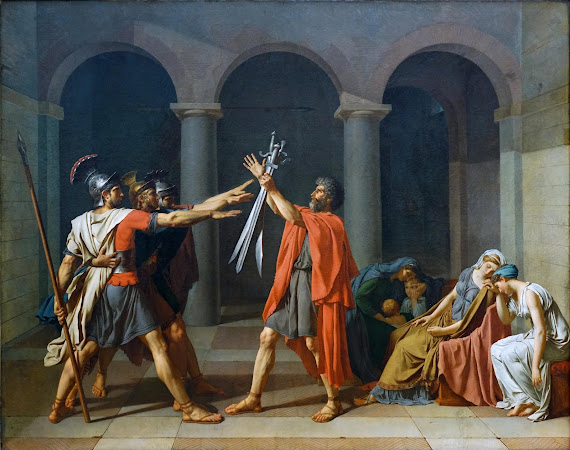Classical Exhibit
Revolution and Art
The American Revolution influenced many different things like the Declaration of Independence, the Bill of Rights, and even the French Revolution. I'm not a huge fan of history, so we don't really need to dive into any of those topics. However, I would like to discuss how the Revolution influenced the Enlightenment period which also inspired new art. The Enlightenment period got people thinking progressively about a better way of life, one where religion didn't control their everyday life. In simpler terms, people wanted a separation of church and state and they were more than willing to fight for it; thus creating the French Revolution.
During the time of the French Revolution, artists became inspired by the Enlightenment period and wanted to stray away from creating religious art. So, a new style emerged called Neoclassical art. Neoclassical art often depicted some elements of the French Revolution like soldiers with weapons or battle scenes and post-battle scenes. There were, however, many portraits of men or women which did not showcase any hint of war. Neoclassical art is more than just paintings of war because it is actually characterized by the clarity of form, sober colors, shallow space, and strong horizontals. Nonetheless, "the Neoclassicists wanted to express rationality and sobriety that was fitting to their times. [Many] artists supported the rebels in the French Revolution through art that asked for clear-headed thinking and self-sacrifice to the State," (Katherine Taylor). So, I suppose it's safe to say you can infer pieces that depict the Revolution are Neoclassical art, however, there are some pieces where you'd have to determine its style by the piece's form, colors, and horizontals.
 |
| "The Oath of the Horatii" By Jacques-Louis David Rome, 1786 |
The Oath of the Horatii is a very well-known piece, but it is a perfect example of Neoclassical art and the influence of the Revolution. In this piece, we see three brothers saluting their father who holds three swords. These brothers are swearing to defeat their enemies or die trying and their father commends them by giving them their weapons. On the side, we can see the women of their family sighing like they're in dismay at their decision. The moment Jacques-Louis David chose to capture was, in his words, "the moment which must have preceded the battle, when the elder Horatius, gathering his sons in their family home, makes them swear to conquer or die” (Khan Academy). This is a very moving piece because it shows the dedication of all men who chose to fight during the Revolution and the sacrifices they made, like leaving behind the women they love. This oil on canvas piece is so well done and really exemplifies Neoclassical art with its sober colors and shallow space contrasted by light. There is a lot of drama packed into it as well but also reflects a sense of passion and rationality. While this is a very well-done Classical piece, I'm not sure if I would own a copy of it- it's definitely something I would rather see once in a museum.
 |
| "Napoleon 1 on His Imperial Throne" By Jean-Auguste-Dominique Ingres Paris, 1806 |
 |
| "The Death of General Wolfe" By Benjamin West Canada, 1776 |
Neoclassical art really does tie into what the Revolution was all about; separating from religion and thinking more progressively. There are so many different Neoclassical pieces out there that depict the French Revolution, however, almost all of them were created by Jacques-Louis David, and I couldn't use him as an example for all three. I strongly recommend you look at some of his other pieces because they are so interesting and are important works of art during the Neoclassical era- and the French Revolution.
Work Cited.
McCoy, Dr. Claire. “David, Oath of the Horatii.” Khan Academy, www.khanacademy.org/humanities/ap-art-history/later-europe-and-americas/enlightenment-revolution/a/david-oath-of-the-horatii.
Taylor, Katherine. “Neoclassicism and the French Revolution.” Humanities LibreTexts, Libretexts, 9 Mar. 2021, human.libretexts.org/Bookshelves/Art/Book%3A_Western_Art_from_18th_to_Mid-20th_Century_(Taylor)/01%3A_Chapters/1.02%3A_Neoclassicism_and_the_French_Revolution.
Zygmont, Dr. Bryan. “Jean-Auguste-Dominique Ingres, Napoleon on His Imperial Throne.” Smarthistory, 29 Nov. 2015, smarthistory.org/ingres-napoleon-on-his-imperial-throne/.

Laura, I find the art of revoultions to be quite interesting, they can tell such a story on a surface level, but when you look deeper, there is still symbolism and on top of it the historical relevance. I think he did a great job going over all of the pieces you chose, and I find that in pieces like "The Death of General Wolfe", and "The Oath of the Horatii" there are all sorts of othere elements to, such as morality. I think the piece of Napoleon on his throne is a fascinating one as we tend to see less art focusing on royalty, and given the fact that many of the rulers were killed or overthrown during the revolution that Napoleon would be depicted in this way. Nice work!
ReplyDeleteI also did my blog post on revolutionary art! In particular, I really liked your discussion of the piece "The Death of General Wolfe." I really liked how you pointed out the use of shallow space in the painting. It is a very interesting feature that isn't common in paintings. I think it is a really good tactic to help the viewer feel more immersed in the painting. It also heightens the emotions and the urgency of the painting.
ReplyDelete